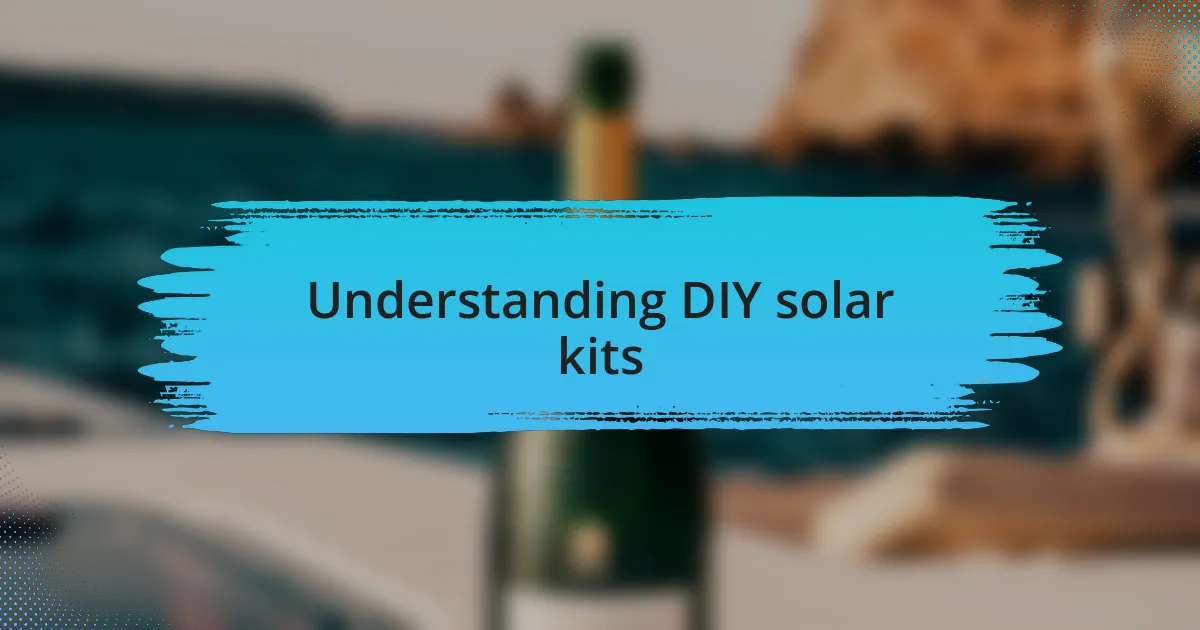Key takeaways:
- DIY solar kits are designed for various energy needs, providing an accessible way to harness solar power, especially for yacht owners.
- Choosing the right solar kit involves considering energy consumption, space, weight, and ease of installation.
- The installation process requires careful attention to detail, including wiring and panel alignment for optimal efficiency.
- Common challenges include managing variable weather conditions, complicated wiring, and the physical effort needed for mounting solar panels.

Understanding DIY solar kits
When it comes to DIY solar kits, they offer an intriguing mix of empowerment and challenge. I remember the first time I unboxed one of these kits—there was a sense of excitement, but also a bit of intimidation. Can I really turn the sunlight into usable energy? The beauty of these kits lies in their design; they come with everything you need to harness solar power, from panels to inverters, making the process feel almost accessible.
Diving deeper, you’ll find that most DIY solar kits cater to a range of energy needs, which can be particularly helpful for boat owners like myself. It’s fascinating how customizable these systems can be; for instance, I installed a compact kit that powered my lights and essential electronics during weekends at sea. Do you see how flexible these solutions can transform your yacht experience?
What truly stands out to me is the learning curve and the sustainability aspect. As I worked my way through the setup, I unearthed a genuine appreciation for renewable energy. This journey wasn’t just about saving on energy costs; it became a personal quest to contribute positively to our environment. Think about it—every bit of energy you harness from the sun reduces your carbon footprint and brings you one step closer to living off the grid.

Choosing the right solar kit
Selecting the right solar kit can be daunting, especially with the variety available for yacht owners. I found myself standing in front of various packages, wondering if I should opt for a larger capacity or a more compact system. It’s essential to understand your energy consumption needs—are you running just lights and small gadgets, or do you want to power appliances like a refrigerator or a cooler?
I remember attaching my first solar panel and marveling at how weight and space matter on a yacht. The kit I ultimately chose was lightweight and fitted snugly on my deck without compromising the sleek lines of my boat. Don’t overlook these considerations; a solar kit should blend seamlessly into your yacht while meeting your energy demands.
Another important factor is the ease of installation. Reflecting on my experience, I found kits that offered detailed guides made all the difference. I appreciate the sense of accomplishment when I successfully installed my system without hiring a professional. After all, what’s more satisfying than reaping the rewards of sunlight after tackling a project independently? Consider what you value most—simplicity in setup or maximum efficiency—before making your choice.

Installation process of solar kits
Installing solar kits can seem overwhelming at first, but I found it surprisingly manageable once I broke it down into steps. The instructions were clear, but I still took my time, ensuring each connection was secure and neat. I remember double-checking the wiring, feeling a mix of excitement and nervousness—what if I missed something crucial?
One of the most satisfying moments for me during the installation was aligning the solar panels for optimal sun exposure. It was like a little puzzle—positioning them just right so they would catch every ray. I can distinctly recall standing back after tightening the last bolt, soaking in the fact that I was now harnessing the sun’s power directly from my own yacht. It’s a unique sense of pride, knowing you’ve engineered your own energy source while drifting gently on the water.
As I connected the battery to the system, I couldn’t help but feel a surge of anticipation. Would it all come together as planned? When the moment finally arrived and I flipped the switch, watching the lights flicker on, it was pure joy—an affirmation that my DIY endeavor had paid off. This experience not only saved me money but also deepened my connection to my yacht, turning it into a charming little power station under the open sky.

Challenges faced during installation
Challenges during the installation of the DIY solar kit were more pronounced than I initially anticipated. One major hurdle was the variable weather—unexpected rain showers made it tough to work efficiently and keep the equipment dry. Have you ever tried to balance a power tool under an umbrella? It’s not exactly conducive to precise installations.
Wiring was another tricky aspect of the process. I found myself staring at a spaghetti mess of cables, trying to make sense of it all. I distinctly recall a moment where I second-guessed my wiring configuration, wondering if I was going to fry my entire setup. It was a learning curve for sure; one that involved a few hours of troubleshooting and a couple of online tutorials.
Then there was the mounting of the solar panels—a task that seemed straightforward but required quite a bit of muscle and strategy. I vividly remember the moment I was up on the yacht’s roof, sweating and struggling to get the panels secure while not dropping a wrench into the water below. It forced me to reevaluate my approach and ask for a friend’s help, which turned out to be a blessing in disguise. There’s something to be said for teamwork, especially when working at altitudes.